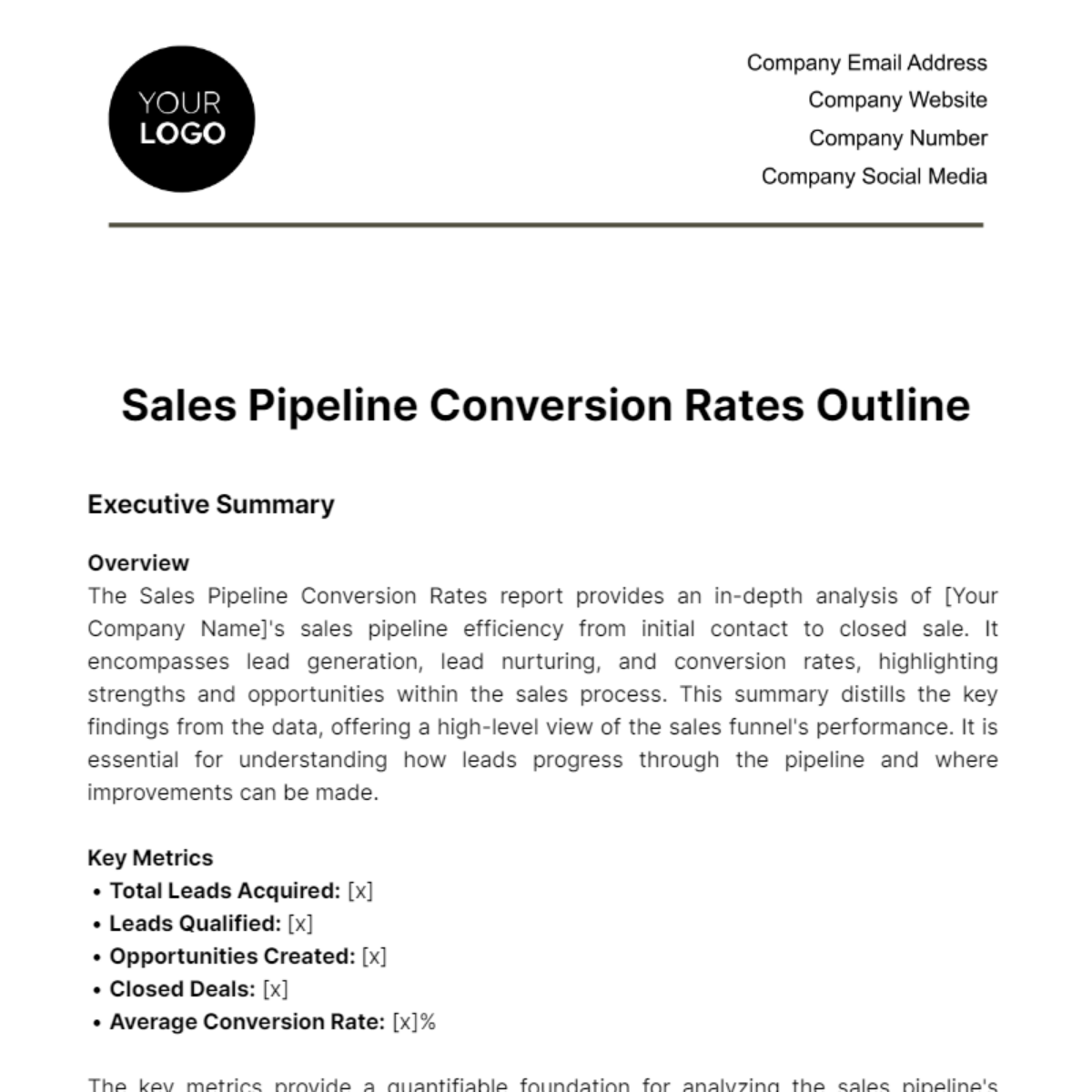Sales Pipeline Conversion Rates Outline
Executive Summary
Overview
The Sales Pipeline Conversion Rates report provides an in-depth analysis of [Your Company Name]'s sales pipeline efficiency from initial contact to closed sale. It encompasses lead generation, lead nurturing, and conversion rates, highlighting strengths and opportunities within the sales process. This summary distills the key findings from the data, offering a high-level view of the sales funnel's performance. It is essential for understanding how leads progress through the pipeline and where improvements can be made.
Key Metrics
Total Leads Acquired: [x]
Leads Qualified: [x]
Opportunities Created: [x]
Closed Deals: [x]
Average Conversion Rate: [x]%
The key metrics provide a quantifiable foundation for analyzing the sales pipeline's health. By examining these figures, we can track progress against sales targets and benchmark our performance against industry standards.
Conversion Rate Goals
Setting ambitious yet achievable conversion rate goals motivates the sales team and provides clear targets to aim for. These benchmarks are essential for assessing the effectiveness of sales strategies and guiding future actions.
Lead Generation Analysis
Lead Sources Breakdown
A comprehensive breakdown of lead sources illustrates which channels are most effective at generating qualified leads. Understanding the conversion rate from each source informs resource allocation and marketing strategy optimization.
Source | Leads Generated | Conversion to Qualified Lead |
Online Ads | [x] | [x]% |
| | |
| | |
| | |
| | |
Lead Quality Assessment
Lead Scoring Model: Utilizes demographic and behavioral data to assess lead quality.
High-Quality Lead Characteristics: Defined as leads that engage multiple times with [Your Company Website] and [Your Company Social Media].
By applying a lead scoring model, we can prioritize leads that are most likely to convert, thereby increasing sales efficiency. The high-quality lead characteristics serve as a guide for marketing efforts to attract leads that demonstrate a genuine interest in our offerings.
Lead Nurturing Tactics
Email Drip Campaigns
Series of [x] emails, tailored based on the lead's industry, with a click-through rate of [x]%.
Content includes industry insights, product benefits, and customer testimonials.
These campaigns are designed to educate and engage leads over time, moving them further along the sales funnel. The click-through rate serves as a measure of the campaigns' effectiveness in engaging potential customers.
Educational Content Offerings
The educational content positions [Your Company Name] as a thought leader while providing value to potential customers. It is a critical component of the nurturing process, leading to more informed and engaged prospects.
Personalized Follow-Ups
Personalized follow-ups are tailored to the lead's engagement, ensuring relevant communication that can significantly improve conversion rates. The personal calls add a human touch to the digital nurturing process, which can greatly enhance relationship building.
Conversion Rate Optimization Strategies
A/B Testing
Conduct A/B testing on email campaigns to improve open rates and click-through rates.
Test different subject lines, content formats, and calls-to-action.
A/B testing is crucial for understanding what resonates with potential customers and drives engagement. This data-driven approach allows for continuous improvement of the communication strategy.
Sales Process Improvements
These improvements are aimed at equipping the sales team with the tools and knowledge they need to be more effective. The use of CRM tools not only increases efficiency but also provides valuable insights into customer interactions.
Pipeline Metrics Tracking
Key Performance Indicators (KPIs)
KPIs are the compass that guides sales efforts, indicating where performance is strong and where there is room for improvement. They provide actionable insights that can drive sales strategy adjustments.
CRM Reporting
CRM reporting provides a granular view of sales activities and pipeline health, enabling rapid response to emerging issues. It also serves as a tool for transparency and accountability within the sales team.
Review and Adjustments
Quarterly Reviews
Quarterly reviews are crucial for ensuring the sales process remains aligned with the changing market and organizational goals. They enable the team to pivot strategies in a timely fashion.
Continuous Improvement
An ethos of continuous improvement keeps [Your Company Name]'s sales practices at the cutting edge. By regularly updating sales training and refining marketing tactics, the organization can maintain its competitive edge.
Sales Templates @ Template.net




























